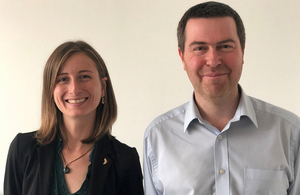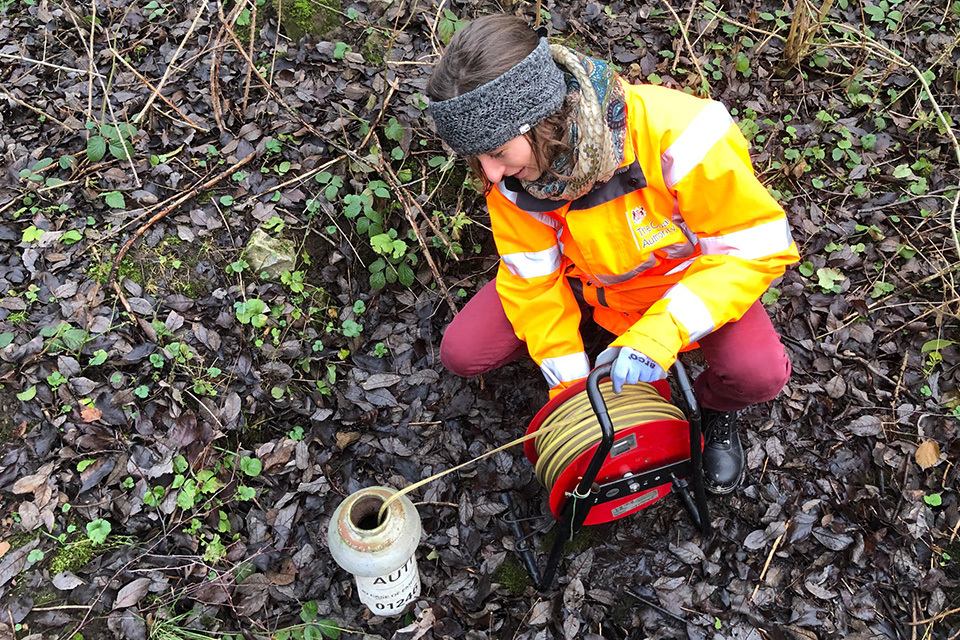Mine water heat under the PhD spotlight
Better understanding of a potential new energy resource for coalfield areas is being researched by a PhD student in conjunction with the Coal Authority.

University of Edinburgh student Mylène Receveur with Dr Ian Watson, technical lead on water for the Coal Authority.
University of Edinburgh student Mylène Receveur is being partly-sponsored by the Coal Authority to expand our understanding of the geothermal warming of mine waters.
Mylène’s thesis - Investigating geothermal heat resources of legacy mine workings, why are some mine waters hotter than others? - will explore the key controls that create differences between different sites.
When mines are abandoned and the pumps which kept them dry are switched off, the roadways, galleries and fractures fill with ground water, which is heated by geothermal energy from the earth’s core to temperatures of 11 to 20°C close to the surface and up to 46°C in deeper coal seams.
This difference in temperatures between mines has always been known and a recent Scottish government study on the geothermal potential of Scotland showed that there is a significant variation down to a depth of about 1,500 metres.
Temperature gradients ranging from 37°C/km to 45°C/km were recorded in 61 boreholes but understanding why mine waters reach a certain temperature is critical to being able to estimate the heat resource and storage potential.
The Coal Authority, which recognises that the past can help shape the future, is particularly interested in understanding this thermal energy resource better, including how quickly mine water heats up and how it could be used on a large scale for heating homes and business for decades to come.
Dr Ian Watson, technical lead on water for the Coal Authority and Mylène’s industry partner, said the Coal Authority is particularly interested in better understanding this resource because it is progressing a large number of district heating schemes that will use mines as their source of energy:
A quarter of UK homes and businesses sit on the former coalfields, where the flooded underground workings contain vast amounts of renewable thermal energy.
We want to work with Mylène to improve our understanding of what the main sources of energy are and how new energy extraction, or energy storage schemes using mine water, will be able to make the best use of the vast underground workings left behind after mining stops.
Several factors are considered to contribute to the temperature profile and the purpose of Mylène’s PhD is to determine what they are and understand the subsurface ‘plumbing’ and heat distribution of mine workings.
French-born Mylène has a master’s degree in geology from the UniLasalle Beauvais Engineering School in Beauvais, Paris, and also achieved a research master’s in geology, specialising in geothermal sciences, from the University of Iceland.
She will be collating data from the Coal Authority and spending time at our Mansfield headquarters.

Mylène Receveur, our placement PhD student, trying her hand for the first time at recording water levels and collecting critical data before our Hartington pumping test.
She said she hopes to develop hydrogeological conceptual models before interpreting the results to ascertain the temperature resources that are available over the long term:
It is a great challenge to understand what factors control the temperature distribution and the heat recharge rate in systems as hydrogeologically complex as coal mines, but this is essential to assess their geothermal potential.
I hope being able to develop a numerical approach that faithfully reproduces heat flow processes in mines could be used to support the dimensioning of heat extraction schemes, first in the UK and ideally reproducible abroad. This is the key to ensure a sustainable heat production from low-temperature geothermal resources.
Jeremy Crooks, head of innovation for the Coal Authority, said the potential to repurpose the abandoned mines to provide a sustainable energy source for the benefit of future generations, and to help reach challenging climate change targets, is very exciting:
Mines are a constant source of sustainable energy, protected from the energy price fluctuations, which will help remove people from fuel poverty and provide business with cheap, low-carbon energy, giving them a commercial advantage, leading to more employment.
To make best use of this asset we do need to know more about the temperatures behaviour and flows within mines - Mylène’s work on this will be invaluable.
Christopher McDermott, Mylène’s principle supervisor at the University of Edinburgh, emphasises that it is important to understand the heat resource and distribution to help ensure its sustainability:
There is always the temptation to extract more heat out of the system than is available by recharge, thereby depleting the resource.
Mylène’s work is important in helping us to balance the heat use and also to investigate ways of enhancing the heat in mines through storage.
For media enquiries contact the community response team
200 Lichfield Lane
Mansfield
Nottinghamshire
NG18 4RG
Email communityresponse@coal.gov.uk
Telephone 0800 288 4211
For emergency media enquiries (out of hours) call: 0800 288 4242.
Only urgent media calls will be attended to.